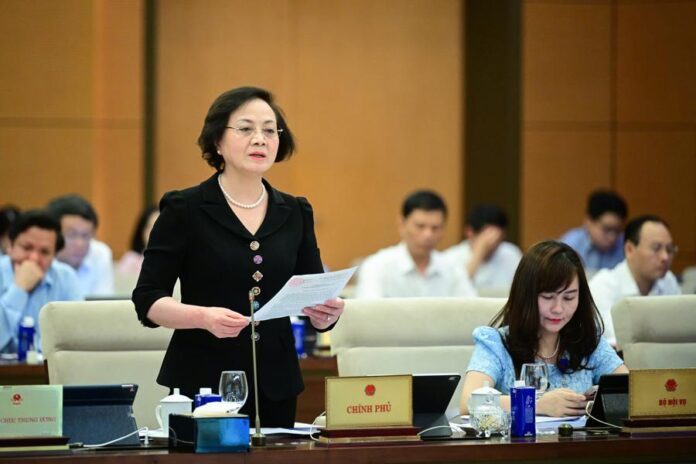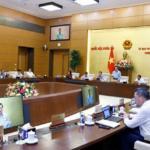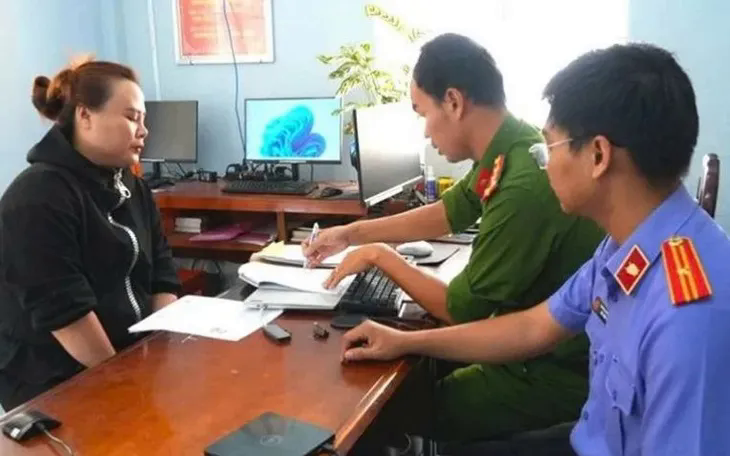On June 5th afternoon, at the 46th Session, the National Assembly Standing Committee gave opinions on the proposal to rearrange administrative units at the provincial level in 2025 and considered and passed in principle the resolutions on rearranging administrative units at the communal level in 2025.
THE COUNTRY HAS 34 ADMINISTRATIVE UNITS AT THE PROVINCIAL LEVEL AND 3,321 AT THE COMMUNAL LEVEL AFTER REARRANGEMENT
Presenting the proposal on rearranging administrative units at the provincial level in 2025, Minister of Home Affairs Pham Thi Thanh Tra made it clear that, strictly following Resolution No. 60-NQ/TW dated April 12, 2025, of the 11th Plenum of the Party Central Committee’s 13th tenure; based on the principles and regulations in Resolution No. 76/2025/UBTVQH15, and taking into account the current situation and development orientation of the 63 provinces and cities across the country, the Government has developed 23 plans to rearrange 52 administrative units at the provincial level to form 23 new administrative units at the same level.
After the rearrangement, the country will have 34 administrative units at the provincial level, including 6 centrally-run cities and 28 provinces. All 23/23 administrative units at the provincial level formed after the rearrangement have met the orientation criteria of administrative units at the provincial level as stipulated in Article 4 of Resolution No. 76/2025/UBTVQH15.
In terms of procedure, the Government has assigned localities to develop plans to rearrange administrative units for each pair of provinces; organize consultations with the people and pass them through People’s Councils at all levels as prescribed. The results of the people’s consultations showed a high consensus rate, averaging 96.19% nationwide, and 100% of the People’s Councils at the provincial, district, and communal levels of the 52 provinces and cities agreed with the policy of rearranging administrative units at the provincial level in their respective localities.
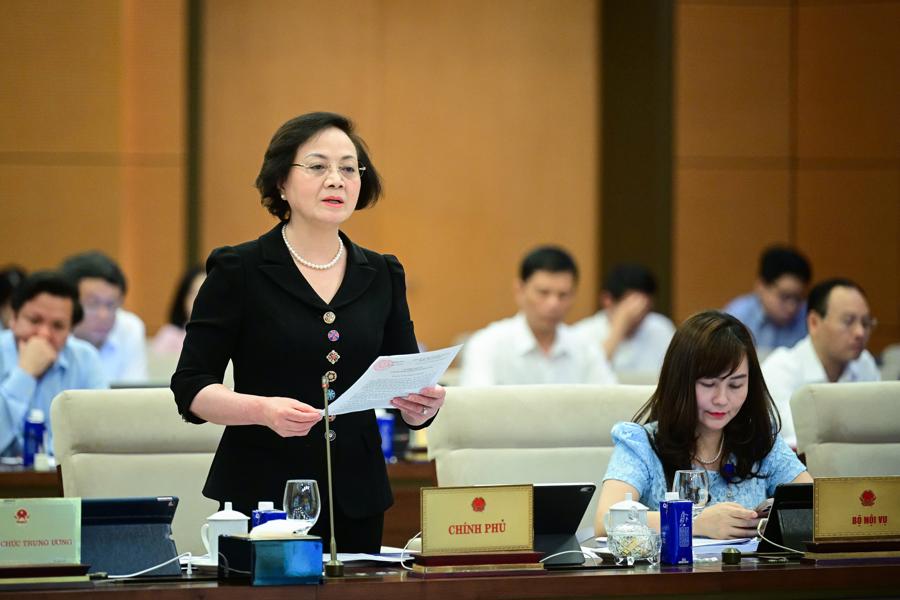
The Ministry of Home Affairs has appraised, synthesized, and built a dossier of the Government’s proposal on rearranging administrative units at the provincial level in 2025. The Government has voted to approve the dossier of the proposal on rearranging administrative units at the provincial level in 2025 to submit to the National Assembly.
Minister Pham Thi Thanh Tra said that after the rearrangement, the number of officials, civil servants, and public employees at the provincial level shall not exceed the total number of officials, civil servants, and public employees (present) at the provincial level before the rearrangement. Rationalization of personnel shall be carried out in association with restructuring and improving the quality of the team of officials, civil servants, and public employees, ensuring that within five years, they will be basically arranged according to regulations.
The arrangement, use, and handling of finances and assets of offices after the rearrangement of administrative units at the provincial level shall be implemented in accordance with the Government’s regulations, the Prime Minister’s directions, and the Ministry of Finance’s guidance. At the same time, the People’s Committees of the rearranging provinces and cities have plans to arrange, use, invest in repairing, upgrading, and improving offices to ensure working conditions for agencies, organizations, and units at the new administrative units at the provincial level.
Also at the session, Minister Pham Thi Thanh Tra presented a summary proposal on the rearrangement of administrative units at the communal level in 2025. Of the current 10,035 administrative units at the communal level nationwide, 9,907 units will be rearranged, and 128 units will remain unchanged (as they have already met both criteria in terms of natural area and population size or have specific factors (separate location) as prescribed in Resolution No. 76/2025/UBTVQH15.
The provinces and cities have developed 3,193 plans to rearrange 9,907 administrative units at the communal level to form 3,193 new administrative units at the same level, reducing 6,714 units.
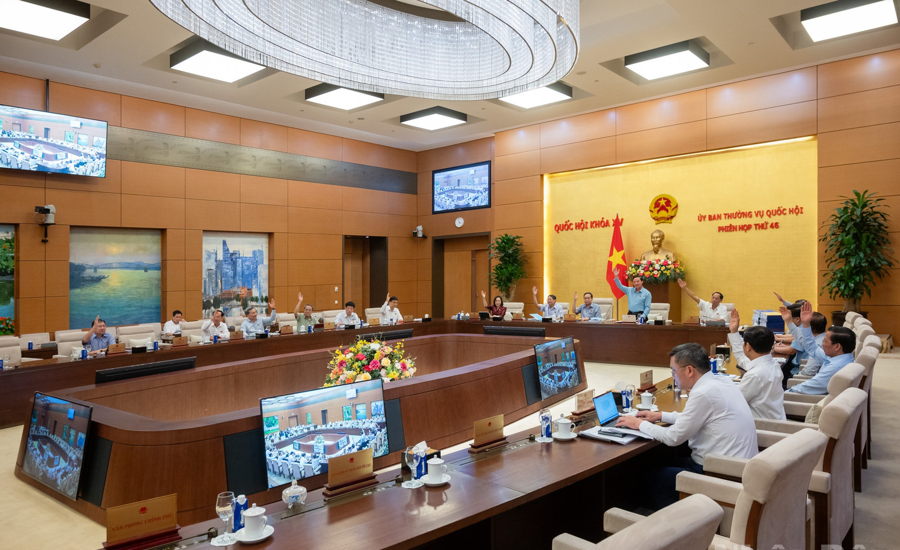
After the rearrangement of administrative units at the communal level in 2025, the country will have a total of 3,321 administrative units at the communal level, reducing 6,714 administrative units at the same level (a reduction rate of 66.91%).
Regarding the procedure, the Minister of Home Affairs said that, based on Resolution No. 76/2025/UBTVQH15 and guiding documents of central agencies, the People’s Committees of the provinces and cities have built dossiers of proposals on rearranging administrative units at the communal level in 2025, organized consultations with the people, and passed them through the People’s Councils at all levels as prescribed.
The results of the people’s consultations showed a high consensus rate, with an average of nearly 96% of voters from representative households agreeing, and 100% of the People’s Councils at the provincial, district, and communal levels of the provinces and cities agreeing with the policy of rearranging administrative units at the communal level in their respective localities.
Based on the dossiers of the 63 provinces and cities, the Ministry of Home Affairs has appraised and synthesized to build 34 dossiers of the Government’s proposals on rearranging administrative units at the communal level according to the new pairs of provinces, submitting them to the Government for approval before submitting them to the National Assembly Standing Committee for consideration and decision.
The proposal also clearly states the plan to arrange and consolidate the organizational apparatus, arrange and assign officials, civil servants, and public employees after the rearrangement of administrative units at the communal level, and arrange and assign offices, handle finances and assets.
Next, Chairman of the National Assembly’s Committee for Legal Affairs and Judiciary Hoang Thanh Tung presented opinions on the proposals and plans of the Government on rearranging administrative units at the provincial and communal levels in 2025.
PERSONNEL WORK MUST BE PAID ATTENTION TO AFTER REARRANGEMENT
Discussing the rearrangement of administrative units at the provincial and communal levels, the members of the National Assembly Standing Committee basically agreed with the plan to rearrange administrative units at the provincial level in 2025 according to the Government’s proposal and the draft Resolution on rearranging administrative units at the provincial level in 2025, with a plan to merge 53 provinces and centrally-run cities into 23 new provinces and cities.
Speaking at the session, National Assembly Chairman Tran Thanh Man stated that the National Assembly Standing Committee decided to merge the communal-level administrative units from 10,035 to 3,321.
The National Assembly Chairman appreciated the preparation of the Government, the Ministry of Home Affairs, and the appraisal report of the Committee for Legal Affairs and Judiciary. The National Assembly Chairman acknowledged that the Ministry of Home Affairs has been working very urgently in the spirit of “running and queuing” and working with localities; this time, the merger has organized consultations with the people of each household and individual; localities have paid much attention and proactively implemented this policy.
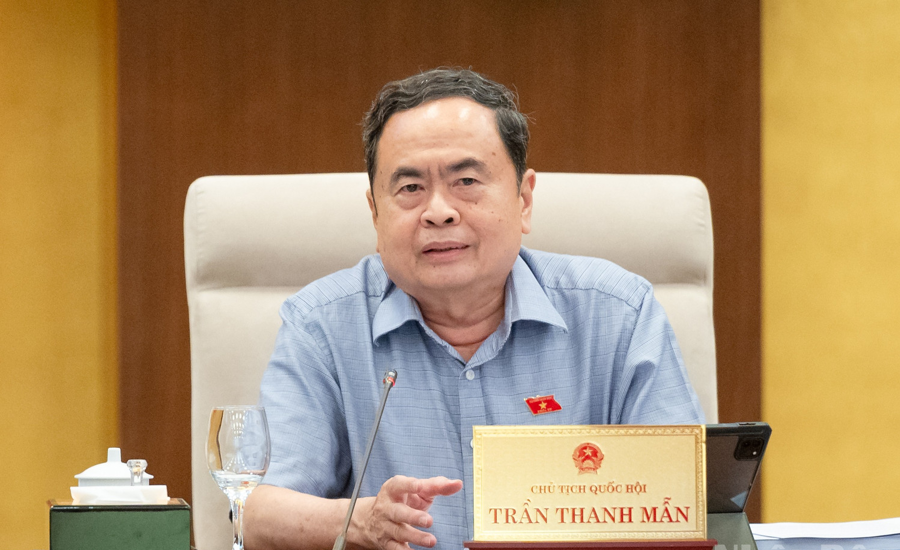
The National Assembly Chairman requested that the Resolution should be concise and clear, ensuring legality and compliance with the regulations of the Party, State, and law. The Ministry of Home Affairs, the Committee for Legal Affairs, and the Judiciary continue to review the names of administrative units and ensure that all data is accurate and correct when the Resolution is issued.
At the same time, ensure that the Resolution is implemented according to the roadmap set by the Central Steering Committee; continue to propagate to create consensus among the people.
The National Assembly Chairman pointed out that personnel work must be paid attention to after the rearrangement, and policies for full-time and part-time officials must be resolved. Among the 3,321 communes after the rearrangement, who will be the leaders, who will be the Secretary, Deputy Secretary, Chairman of the People’s Committee, and Vice Chairman? Who will be the Chairman of the People’s Committee must be an official with experience and understanding of state administration. This position is extremely important because there will be more than 1,000 tasks at the district level transferred to the communal level. In addition, there are tasks directly assigned by the provincial level to the communal level to promote socio-economic development, ensure national defense and security, and build a strong government.
“The goal is a strong commune, a strong province, and a strong central. Therefore, the Ministry of Home Affairs needs to continue to direct localities to implement this content,” said the National Assembly Chairman.
The National Assembly Chairman also noted the issue of handling redundant assets after the rearrangement of administrative units to avoid the situation of “lack where needed, and unused where available.”
Regarding the proposal to rearrange administrative units at the provincial level, the National Assembly Chairman stated that the Resolution is also different from before, as it only stipulates general principles, and then the Government continues to issue decrees to guide, and the ministries will have circulars to guide localities.
“Decentralization and delegation of power must be calculated, applying information technology, digital transformation, artificial intelligence in the implementation of rearranging administrative units and propagating and disseminating legal knowledge,” said the National Assembly Chairman.
Emphasizing that rearranging administrative units at the provincial and communal levels is an extremely important and complicated task, the National Assembly Chairman said that this requires careful consideration, compliance with the law, and accurate calculation because it is related to streamlining the apparatus and, above all, ensuring political stability, security, and the interests of the people. Along with that, it is necessary to have a consensus from within the apparatus to the people to be able to implement successfully, contributing to the Party’s great policy.
“In this historical period, the National Assembly Standing Committee and the National Assembly decide on historical issues of the country, and the people expect this rearrangement of administrative units to create new momentum and a new face for socio-economic development, ensuring national defense and security, and a streamlined apparatus,” said the National Assembly Chairman.
“Vietnam’s Administrative Efficiency: Streamlined to 3,321 Commune-Level Units Nationwide”
As of 2025, there are 3,321 administrative units at the commune level across the country, including 2,621 communes, 687 wards, and 13 special districts, reflecting a significant reduction of 6,714 units, which equates to a remarkable 66.91% decrease.
“Affordable Housing Should Be Accessible, Not Relegated to Inaccessible Locations: Prime Minister”
In the afternoon of June 2nd, Prime Minister Pham Minh Chinh chaired a conference to deploy Resolution 201/2025/QH15 of the National Assembly on piloting several special mechanisms and policies for the development of social housing and reviewing and evaluating the situation of social housing development in the first five months of 2025, as well as the implementation plan for the remaining months of this year.
“National Assembly Standing Committee Reviews Proposal for 2025 Provincial-Level Administrative Unit Restructuring”
The upcoming legislative agenda includes three key bills: the Local Government Organization Law, the Civil Servants and State Employees Law (amended), and a proposal for the rearrangement of provincial-level administrative units for 2025. The National Assembly Standing Committee will provide feedback on these critical initiatives, offering insights and guidance to shape the future of local governance and civil service regulations in the coming year.

